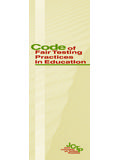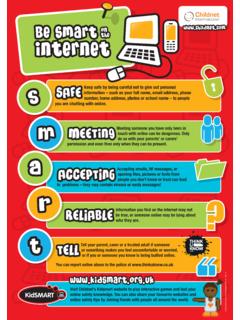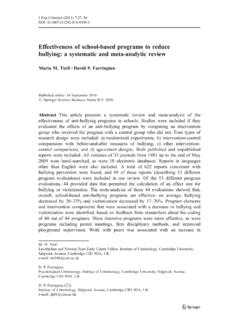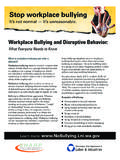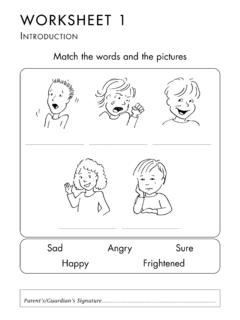Transcription of BE IT FURTHER RESOLVED that the APA encourage …
1 APA Resolution on Bullying Among Children and Youth July 2004. WHEREAS bullying is commonly characterized as aggressive behavior that (a) is intended to cause distress or harm, (b) involves an imbalance of power or strength between the aggressor and the victim, and (c) commonly occurs repeatedly over time (Limber, 2002; Olweus, 1993a; Nansel et al., 2001);. WHEREAS bullying may take many forms, including physical bullying; teasing or name- calling; social exclusion; peer sexual harassment; bullying about race, ethnicity, religion, disability, sexual orientation, and gender identity; and cyber bullying (bullying through email, text messaging, or other digital means).
2 WHEREAS bullying, as a form of peer victimization, differs from other forms of aggression among children ( , conflict between peers) (Espelage, Holt, & Henkel, 2003; Olweus, 1993a, 2001; Olweus, Limber, & Mihalic, 1999; Pellegrini, 2002); and WHEREAS research has indicated that bullying involves large numbers of children and youth from the United States in all socio-economic backgrounds, in racial groups that have been studied, and in areas of different population density (urban, suburban, and rural settings)(Nansel et al., 2001); and WHEREAS there are gender differences in the types of bullying that children experience, such that boys are more likely than girls to report being physically bullied by their peers (Harris, Petrie, and Willoughby, 2002; Nansel et al.)
3 , 2001) and girls are more likely than boys to report being targets of rumor-spreading and sexual comments (Nansel et al., 2001). WHEREAS girls report being bullied by boys and girls, while boys report being bullied primarily by other boys (Melton et al., 1998; Olweus, 1993). WHEREAS bullying has been found to be related to negative psychosocial functioning among children who are victimized, including lowered self-esteem (Hodges & Perry, 1996; Olweus, 1993a; Rigby & Slee, 1993); higher rates of depression (Craig, 1998;. Hodges & Perry, 1996; Olweus, 1993a; Salmon 2000; Slee, 1995); anxiety (Craig, 1998;. Hodges & Perry, 1996; Olweus, 1993a; Rigby & Slee, 1993); feelings of loneliness (Kochenderfer & Ladd, 1996; Nansel et al.
4 , 2001); suicidal ideation (Rigby, 1996); and higher rates of school absenteeism (Rigby, 1996);. WHEREAS children and youth with disabilities and children and youth who are lesbian, gay, or trans-gender, or who are perceived to be so may be at particularly high risk of being bullied by their peers (Dawkins, 1996; Hershberger & D'Augelli, 1995; Hunter, 1990; Nabuzka & Smith, 1993; Pilkington & D'Augelli, 1995; Rigby, 2002; Yude, Goodman, & McConachie, 1998; Whitney, Smith, & Thompson, 1994). WHEREAS children and youth who bully are more likely than their peers to hold beliefs supportive of violence (Bosworth, Espelage, & Simon, 1999;) and are more likely to influence their peers to engage in bullying others over time (Espelage et al.
5 , 2003); and WHEREAS research suggests that there is no single cause of bullying. Rather, individual, familial, peer, school, and community factors may place a child or youth at risk for bullying his or her peers. (Limber, 2000; Olweus, Limber, & Mihalic, 1999). WHEREAS research indicates that perpetrating bullying is related to other problem behaviors, including vandalism (Solberg & Olweus, 2003), fighting (Nansel et al., 2001;. Nansel, Overpeck, Haynie, Ruan, & Scheidt, 2003), drinking alcohol (Nansel et al., 2001), smoking (Nansel et al., 2001), truancy (Byrne, 1994), dropping out of school (Byrne, 1994), carrying weapons (Nansel et al.
6 , 2003), high-risk gun ownership ( , guns owned for reasons other than sport; Cunningham, Henggeler, Limber, Melton, & Nation, 2000), and other antisocial behaviors (Solberg & Olweus, 2003); and WHEREAS numerous bullying prevention programs, curricula, and strategies have been developed in recent years for use in schools ( Beane, 1999; Committee for Children, 2001; Froschl, Spring, & Mullin-Rindler, 1998; Garrity, Jens, Porter, Sager, & Short- Camilli, 1994; Newman, Horne, & Bartalumucci, 2000; Olweus, 1993a; Stein & Sjostrom 1996); and WHEREAS existing research indicates that bullying at school may be significantly reduced through comprehensive, school-wide programs that are designed to change norms for behavior (Olweus, 1993a; Olweus, 1993b; Olweus, Limber, & Mihalic, 1999.
7 Whitney, Rivers, Smith, & Sharp, 1994); and WHEREAS social stereotypes may convey the impression that certain ethnic or socio- economic groups are more likely to bully and perpetrate violence. However, research findings reveal no significant racial differences in the rates of bullying (Nansel et al., 2001). WHEREAS research, intervention, and policy efforts regarding bullying should therefore consider the potential impact of social stereotypes. WHEREAS, psychologists have played critical roles in conducting research on bullying and in developing bullying prevention interventions ( , Olweus, 1993a; Nansel et al., 2001; Rigby, 1996; Smith & Sharp, 1994).
8 THEREFORE BE IT RESOLVED that the American Psychological Association integrate bullying prevention into its violence prevention activities and, where appropriate, into other activities of its directorates, divisions, and state and provincial psychological associations;. BE IT FURTHER RESOLVED that the American Psychological Association encourage appropriate public and private funding agencies to support ecologically valid and culturally sensitive research on bullying behavior and antibullying interventions; and BE IT FURTHER RESOLVED that the APA integrate its bullying prevention work into initiatives with other associations, governmental entities, and other interested parties in the dissemination of information that will help school administrators and staff, parents, mental health professionals, children and youth, and others to prevent bullying among children and youth.
9 And BE IT FURTHER RESOLVED that the APA encourage vigorous evaluations of bullying prevention programs used in schools, after-school programs, and other settings; and BE IT FURTHER RESOLVED that the APA encourage the implementation and dissemination of bullying prevention programs and interventions that have demonstrated effectiveness in schools and communities and that are culturally sensitive. References Beane, (1999) Bully free Classroom. Minneapolis: Free Spirit Press. Bosworth, K., Espelage, D. L., & Simon, T. (1999). Factors associated with bullying behavior in middle school students. Journal of Early Adolescence, 19, 341-362.
10 Byrne, B. J. (1994). Bullies and victims in school settings with reference to some Dublin schools. Irish Journal of Psychology, 15, 574-586. Committee for Children (2001) Steps to respect. Seattle: Author. Craig, W. M. (1998). The relationship among bullying, victimization, depression, anxiety, and aggression in elementary school children. Personality and Individual Differences, 24, 123-130. Cunningham, P. B., Henggeler, S. W., Limber, S. P., Melton, G. B., & Nation, M. A. (2000). Patterns and correlates of gun ownership among nonmetropolitan and rural middle school students. Journal of Clinical Child Psychology, 29, 432-442. Dawkins, J.









